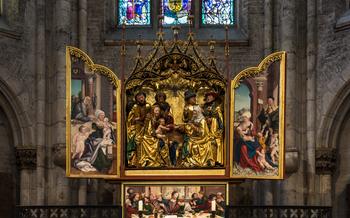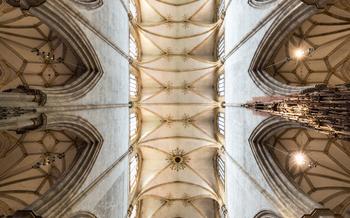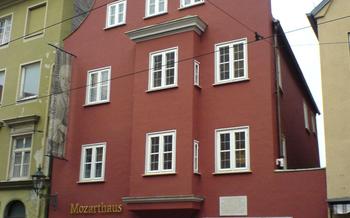
The Ulm School of Design (Hochschule für Gestaltung Ulm)
- A Symbol of Modernist Design:
- Architectural Masterpiece
- Educational Visionaries
- Innovative Curriculum
- Multidisciplinary Approach: Breaking the Boundaries of Design
- International Outlook
- Influential Alumni
- Design Research Center: A Hub for Innovation
- Legacy and Impact: Shaping the Trajectory of Contemporary Design
- Exhibitions and Events
- Guided Tours: An Immersive Experience into the World of Design
- Publications and Archives
- Collaborative Projects
- Community Engagement
- Insider Tip: Exploring Ulm and its Surroundings
A Symbol of Modernist Design:
The Ulm School of Design stands as a testament to the transformative power of design. Established in 1953 in the city of Ulm, Germany, this pioneering institution emerged as a beacon of modernist design, deeply rooted in the legacy of the Bauhaus movement. The Bauhaus, founded by Walter Gropius in 1919, revolutionized the field of design by emphasizing the integration of art, craft, and technology. The Ulm School embraced this legacy, extending its principles to a broader spectrum of design disciplines, including industrial design, graphic design, and information design.
In an era marked by post-war reconstruction and economic recovery, the Ulm School emerged as a catalyst for innovation. Its founders, including Inge Aicher-Scholl, Otl Aicher, and Max Bill, were visionaries who recognized the immense potential of design to shape a better future. They believed that design should not merely be an aesthetic pursuit but should actively contribute to societal progress and well-being. This forward-thinking philosophy set the stage for the school's groundbreaking approaches to design education and methodology, which would leave an indelible mark on the world of design.
Architectural Masterpiece
The Ulm School of Design building stands as an embodiment of modernist design principles, reflecting the collaborative efforts of architect Max Bill and designer Otl Aicher. Completed in 1955, the structure exudes a striking simplicity and functionality, characterized by clean lines, geometric forms, and an interplay of materials. Bill's architectural vision aligned seamlessly with the school's philosophy, emphasizing the integration of art and architecture.
The building's design prioritizes functionality, with spacious studios, workshops, and classrooms arranged around a central courtyard. Natural light floods the interiors through expansive windows, creating a bright and inspiring learning environment. The use of exposed concrete, glass, and steel further reinforces the building's modernist aesthetic.
Recognized as a landmark of 20th-century architecture, the Ulm School of Design building has received numerous accolades for its innovative design. It stands as a testament to the enduring legacy of the school and its commitment to pushing the boundaries of design thinking.
Educational Visionaries
The Ulm School of Design was shaped by the groundbreaking ideas and leadership of several key figures. Inge Aicher-Scholl, co-founder of the school, played a pivotal role in establishing its unique educational approach. She emphasized the importance of interdisciplinary studies and social responsibility in design. Aicher-Scholl believed that designers should not only focus on aesthetics but also consider the ethical and societal implications of their work.
Another influential figure was Tomás Maldonado, who served as the school's second rector. Maldonado introduced critical thinking and systems theory into the design curriculum. He argued that designers should understand the complex interactions between different elements in a system to create effective and sustainable solutions.
Otl Aicher, a prominent graphic designer and co-founder of the school, made significant contributions to the field of visual communication and corporate identity. He developed a systematic approach to visual design, emphasizing clarity, simplicity, and functionality. Aicher's work had a profound impact on the development of corporate identity programs for companies such as Lufthansa, Braun, and ERCO.
These visionary educators laid the foundation for the Ulm School of Design's innovative educational approach, which continues to influence design education worldwide.
Innovative Curriculum
The Ulm School of Design pioneered an innovative approach to design education, emphasizing practical application and real-world problem-solving. In contrast to traditional art schools, the curriculum at Ulm focused on interdisciplinary studies, combining theory, experimentation, and hands-on projects. Students were encouraged to engage in workshops, seminars, and collaborations with industry professionals, gaining valuable experience and insights into the design process. This unique approach aimed to equip students with the skills and knowledge necessary to address complex design challenges and make a meaningful impact in the professional world.
Multidisciplinary Approach: Breaking the Boundaries of Design
The Ulm School of Design embraced a multidisciplinary approach to education, recognizing that design is not confined to a single discipline. Students from diverse backgrounds, including design, engineering, social sciences, and beyond, came together to explore the intersections of various fields. This cross-pollination of ideas fostered a holistic understanding of design's role in society.
-
Collaborative Projects: Teamwork was central to the school's philosophy, with students collaborating on projects that required input from different perspectives. This collaborative approach mirrored the real-world scenarios designers often encounter, where they must work with professionals from various disciplines to create effective solutions.
-
Interdisciplinary Studios: The school established interdisciplinary studios where students from different backgrounds worked together on real-world design challenges. These studios provided a platform for students to apply their knowledge and skills to practical problems, developing a comprehensive understanding of the design process.
-
Breaking Down Silos: The Ulm School of Design actively sought to break down the traditional boundaries between disciplines. By encouraging students to think beyond their own fields, the school fostered a culture of innovation and creativity, where new ideas could emerge from unexpected collaborations.
-
Holistic Designers: The multidisciplinary approach produced graduates who were not simply designers but holistic thinkers capable of addressing complex design problems from multiple perspectives. This well-rounded education prepared students for successful careers in various design fields, where they could apply their interdisciplinary skills to create meaningful and impactful solutions.
International Outlook
The Ulm School of Design embraced an international outlook, fostering a diverse community of students and faculty from around the world. This cosmopolitan environment encouraged global perspectives and cultural exchange, enriching the educational experience and broadening the horizons of all involved.
Collaboration with international institutions and organizations was a cornerstone of the school's approach. Partnerships with universities, design schools, and industry leaders from various countries facilitated the exchange of ideas, best practices, and research findings. These collaborations contributed to the school's reputation as a global hub of design innovation.
The school's commitment to internationalism extended beyond the classroom. Regular exhibitions, workshops, and conferences attracted participants from around the world, creating a platform for cross-cultural dialogue and understanding. These events showcased the school's diverse perspectives and celebrated the richness of global design traditions.
By promoting cross-cultural understanding through design, the Ulm School of Design played a significant role in shaping a more inclusive and interconnected design community. The school's legacy continues to inspire designers worldwide to embrace diversity and collaboration as essential elements of their practice.
Influential Alumni
The Ulm School of Design has produced a remarkable roster of alumni who have left an indelible mark on the world of design. Among them is Otl Aicher, a renowned graphic designer and typographer who played a pivotal role in shaping the visual identity of Germany after World War II. Aicher's work extended beyond graphic design, encompassing corporate identity, exhibition design, and environmental graphics. His contributions to the field earned him international recognition and numerous prestigious awards, including the Grand Prix at the 1964 Milan Triennale.
Another notable alumnus is Tomás Maldonado, an Argentinian designer, educator, and theorist. Maldonado's work focused on the intersection of design, art, and technology. He was instrumental in developing the Ulm School's groundbreaking curriculum, emphasizing critical thinking, systems theory, and interdisciplinary collaboration. Maldonado's writings and teachings have influenced generations of designers and design educators worldwide.
Another prominent alumnus is Inge Aicher-Scholl, a pioneering designer, educator, and activist. Aicher-Scholl was deeply committed to social responsibility and the ethical implications of design. She played a crucial role in shaping the Ulm School's curriculum, incorporating subjects such as sociology, history, and psychology into the design education. Aicher-Scholl's work extended beyond the classroom; she was actively involved in social and political movements, using design to promote peace, understanding, and social justice.
Design Research Center: A Hub for Innovation
The Ulm School of Design established the Ulm School of Design Research Center as an integral part of its commitment to theoretical and practical research in various design disciplines. The center serves as a platform for faculty, students, and researchers to engage in cutting-edge explorations, pushing the boundaries of design knowledge and innovation.
The research center focuses on a diverse range of topics, including product design, graphic design, industrial design, and design theory. Through collaborations with industry partners, the center addresses real-world design challenges, contributing to the advancement of design methodologies and theories.
The center's research outcomes are disseminated through various channels, including publications, conferences, and exhibitions. These outputs not only contribute to the advancement of design knowledge but also provide valuable insights for practitioners, educators, and policymakers.
The Ulm School of Design Research Center is a testament to the school's commitment to fostering a culture of innovation and intellectual inquiry. It has become a hub for design research, attracting scholars and practitioners from around the world who are dedicated to exploring the frontiers of design thinking.
Legacy and Impact: Shaping the Trajectory of Contemporary Design
The Ulm School of Design has left an enduring legacy on the world of design. Its innovative approach to design education and methodology has been widely adopted by other design schools and institutions, contributing to the dissemination of the Ulm Model and its principles. The school's emphasis on interdisciplinary collaboration, critical thinking, and real-world problem-solving has shaped the trajectory of contemporary design thinking, influencing the way designers approach their work and address complex societal challenges.
The school's alumni have made significant contributions to various fields of design, including product design, graphic design, and architecture. Notable graduates include designers such as Dieter Rams, Otl Aicher, and Tomás Maldonado, who have become influential figures in their respective domains. Their work has been recognized and celebrated internationally, earning prestigious awards and accolades. The success of Ulm's alumni is a testament to the school's ability to nurture and develop talented designers who have gone on to make a lasting impact on the design world.
Exhibitions and Events
The Ulm School of Design is not just a place of learning and research; it is also a vibrant hub for design exhibitions and events. Throughout the year, the school organizes a variety of exhibitions showcasing the works of students, faculty, and alumni. These exhibitions offer a unique opportunity to witness the creative energy and diverse talents of the school's community. Visitors can explore a wide range of design disciplines, from product design and graphic design to architecture and interior design.
In addition to exhibitions, the school also hosts workshops, lectures, and conferences on various design-related topics. These events bring together experts from different fields to share their knowledge and insights on the latest trends and developments in design. Visitors have the chance to engage with renowned designers, educators, and researchers, and gain valuable insights into the world of design.
Whether you are a design enthusiast, a student, or simply someone curious about the world of design, the Ulm School of Design offers a plethora of opportunities to learn, engage, and be inspired. By attending exhibitions, workshops, and events, visitors can immerse themselves in the creative atmosphere of the school and gain a deeper appreciation for the power of design.
Guided Tours: An Immersive Experience into the World of Design
Guided tours at the Ulm School of Design provide an immersive experience for visitors and groups, offering a deeper understanding of the school's history, architecture, and educational philosophy. Led by knowledgeable guides, these tours take visitors on a journey through the campus, showcasing the iconic school building and design studios. Along the way, visitors gain insights into the school's founding principles, its pioneering approaches to design education, and the legacy of its influential figures.
Personal anecdotes and stories from former students or staff add a human touch to the tours, bringing the school's history to life. Visitors can learn about the challenges and triumphs of the school's early years, the creative atmosphere that fostered innovation, and the impact of the Ulm Model on design education worldwide.
Whether you're a design enthusiast, a student, or simply curious about the world of design, a guided tour of the Ulm School of Design is a must-do experience. It offers a unique opportunity to explore the birthplace of modern design and gain valuable insights into the minds and methods of some of the most influential designers of the 20th century.
Publications and Archives
The Ulm School of Design's rich legacy is not only reflected in its physical presence but also in its extensive collection of publications and archives. The school's library houses a treasure trove of books, journals, and other printed materials related to design, offering a comprehensive resource for researchers, students, and design enthusiasts alike. These publications cover a wide range of topics, from the history and theory of design to practical applications in various fields.
In addition to its library collection, the school also maintains an extensive archive containing historical documents, photographs, and drawings that provide valuable insights into the school's history, educational philosophy, and design methodologies. These archives offer a unique opportunity to trace the development of design thinking at Ulm and to explore the contributions of its influential figures.
The school's commitment to preserving and sharing its rich heritage is evident in its ongoing efforts to digitize and make accessible its collection of publications and archival materials. Through online databases and digital repositories, researchers and the public can access a wealth of information about the Ulm School of Design, its groundbreaking ideas, and its lasting impact on the world of design.
Collaborative Projects
The Ulm School of Design embraces collaboration as an essential driver of innovation and knowledge-sharing. It actively engages in partnerships with other institutions, organizations, and businesses to foster cross-disciplinary projects and initiatives. These collaborations provide students and faculty with opportunities to work on real-world design challenges, gaining valuable experience and insights. Joint research projects, workshops, and exhibitions allow for the exploration of diverse perspectives and the exchange of ideas, leading to innovative solutions and outcomes. Through these collaborations, the school aims to contribute to the broader design community and address societal needs while promoting a culture of collaboration and knowledge transfer.
Community Engagement
The Ulm School of Design actively engages with the local community through various outreach programs and initiatives. This commitment stems from the belief that design should not be confined to the classroom but should have a tangible impact on society. The school organizes workshops, talks, and events that are open to the public, aiming to promote design literacy and awareness among diverse audiences. These initiatives create a platform for students, faculty, and community members to come together, share ideas, and collaborate on projects. By fostering a vibrant design ecosystem in Ulm, the school contributes to the city's cultural landscape and enriches the lives of its residents.
Insider Tip: Exploring Ulm and its Surroundings
While visiting the Ulm School of Design, take the opportunity to explore the captivating city of Ulm and its picturesque surroundings. Discover the awe-inspiring Ulm Minster, a masterpiece of Gothic architecture that dominates the city's skyline. Admire its intricate carvings, soaring spires, and breathtaking stained-glass windows. Stroll along the banks of the majestic Danube River, a serene oasis that offers stunning views and a tranquil atmosphere. Immerse yourself in the local culinary scene, savoring the delectable flavors of Swabian and Bavarian cuisine. Indulge in hearty dishes such as Maultaschen ( Swabian ravioli) and Weißwurst (white sausage) paired with a refreshing glass of local beer. Ulm offers a harmonious blend of history, culture, and natural beauty, making it an ideal destination for those seeking a well-rounded travel experience.









